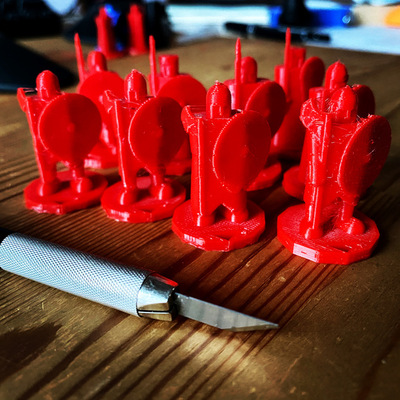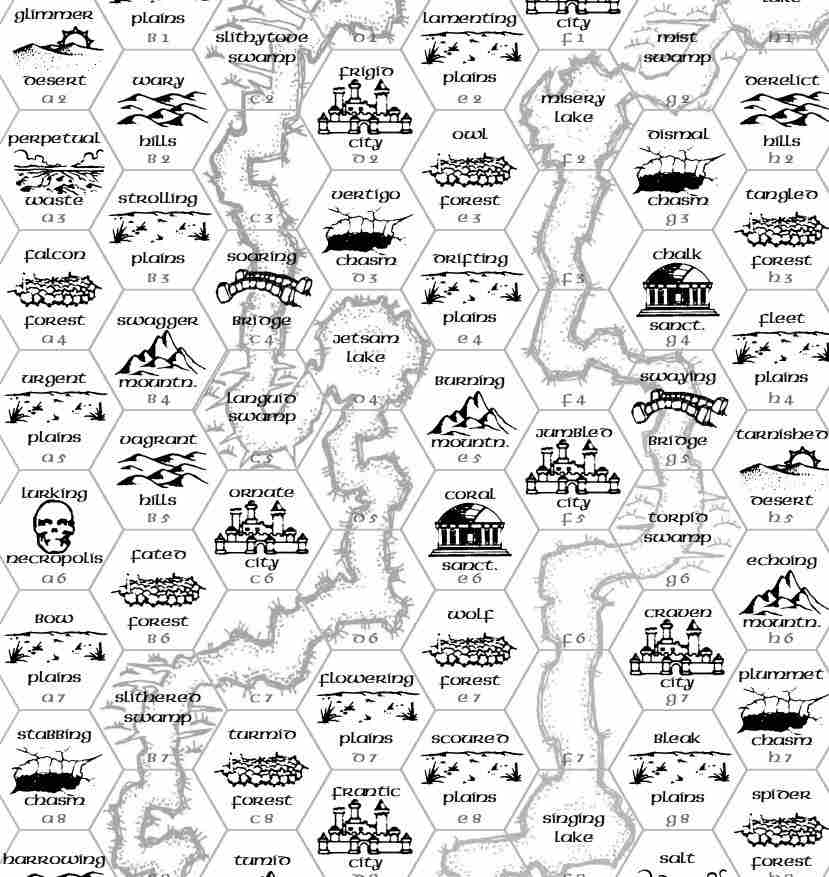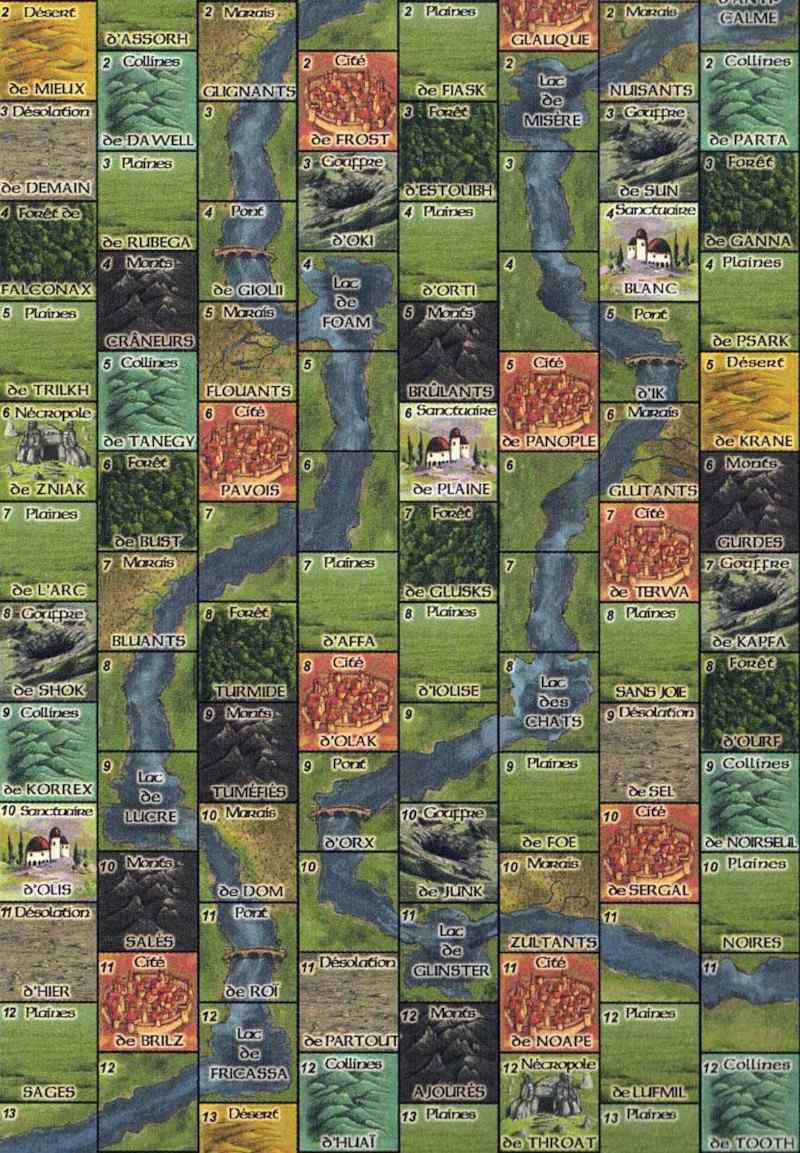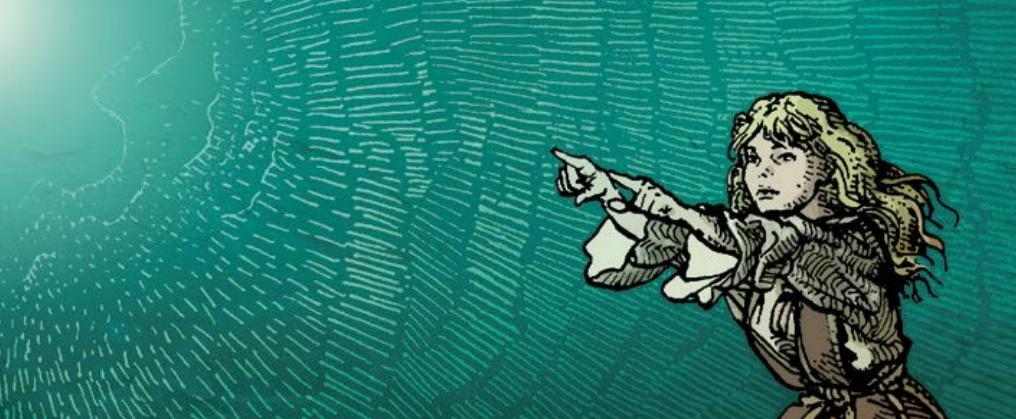
|
Dream Midlands |
| 2022-09-15 |
Dream Midlands

Spellcasters in Rêve de Dragon are called "High-Dreamers", they go into a transe-like half-dream and crawl through the intermediate dreamlands until they reach an hex appropriate to cast their spell. This post highlights the main parts of this magical system.
The map on the right is the version of this hexcrawl that comes with the english translation of the game. Each hex has a name and coordinates, the next time a high-dreamer ascends to cast a spell, they start in the hex they left.
There are 189 of those hexes, upon creation a high-dreamer character chooses where they start on that map. There are 14 types of hexes — cities, sanctuaries, hills, forests, deserts, chasms, swamps, necropolis, ... Each hex has a unique name, like "Derelict Hills" or "Leviathan Waste". A spell is linked to a type of hex where it can be cast, some spells can only be cast in specific hexes, for example, "Fleet Steeds" can only be cast from "Fleet Plains" (H4).
The dreamlands are crossed by a the "River of Oblivion", wet hexes defined by this river are much more dangerous than regular hexes. Wet hexes with bridges can be travelled to almost safely.
To ascend to the dream midlands, the high-dreamer must concentrate, not move and be in control of their body. Ascending costs 1 dream point. The high-dreamer ascends. His friends left behind look at a face that appears moonstruck.
One round in the dream midlands is equivalent to one round in the "normal world". That means that our high-dreamer, while casting is immobile and doing his mental hexcrawl while his friend cover for him. It might be inconvenient for a spellcaster to have to travel dreamland to reach the right hex to cast. Fortunately, a spell can be put in reserve on its hex. It will trigger the next time the high-dreamer ascends.

A spell put in reserve triggers as soon as the high-dreamer ascends to the hex or crawls to it, but encounters are rolled before the trigger, so an encounter that sweeps the dreamer to another hex might prevent the triggering. The dreamer has to carefully keep track of where such untriggered spells are (the referee HAS to keep track :-) ).
The River of Oblivion acts as a single hex with respect to spells put in reserve. Entering a river/lake/swamp hex triggers any spell placed anywhere along the river.
As hinted above, upon entering a hex, the first thing is to roll for an encounter, a 7 on a d7 and the referee will roll on the encounter table. Its percentages are balanced differently according to the hex type (city, plain, forest, ...). There are 10 possible encounters. Each encounter has a strength level, determined by a roll like 2d4 or 2d8, as indicated by the table.
An encounter can be either mastered, avoided, or suppressed. To master an encounter, the high-dreamer has to roll successfully against the encounter. To avoid, the high-dreamer simply breaks their dream and leaves the dream midlands, while the encounter stays put on the hex for 24 hours. To suppress the encounter is to make as if it didn't exist, the high-dreamer increments their suppression gauge and roll a d20; if greater than the gauge count, the encounter is successfully suppressed; else, the gauge count is back to zero, but the high-dreamer is hit by a "Dragon Breath".
The first of the encounters is the Dream Messenger, a mastered messenger lets a high-dreamer cast a spell from a hex distant by as many hexes as the strength of the encounter. Once the spell is cast, successfully or not, the dreamer is back to the hex where they encountered the messenger. An unmastered messenger simply vanishes. A Dream Smuggler is similar to a messenger, but it really carries (teleports) the high-dreamer to the target hex, effortlessly. A high-dreamer may decide not to use a master dream messenger or dream smuggler.
The Dream Flower if mastered grants the dreamer its strength in dream points. Conversely, a Dream Eater, unless mastered, eats dream points from the high-dreamer, as many as it has strength points.
The Dream Changer is similar to the dream smuggler, but the teleportation occurs between hexes of similar type, city to city, or hills to hills, for example. There is no distance limitation. If mastered, the high-dreamer chooses the destination, else the referee chooses, but does not indicate to the player where exactly the dreamer arrived. The player has the map, they know they're in a city or in a plain, but they don't know which one. They'll have to crawl to an adjacent hex to determine where they really are.
If it isn't mastered, the Dream Breaker will shatter the high-dreamer's concentration and force them to leave the dream midlands.
A Reflection of an Ancient Dream, unless mastered, will trap the high-dreamer on its hex and prevents them from casting. Each round, the dreamer must try to master this encounter. Once they have decided to try to master the reflection, the dreamer may not switch to suppression or avoidance. The dreamer can be "rescued" from outside (from below), or as being trapped costs 1 fatigue point per round, falling to exhaustion; both exits require a suppression roll which, if failed, exposes the dreamer to a "Dragon Breath".
A White Whirlwind is similar to a reflection, a kind of trap, but it moves to a random adjacent hex each round, carrying the dreamer with it. The dreamer is trapped until it masters the encounter. For example, if the dreamer failed two times to master the whirlwind, they will be dropped two hexes away from the place where they encountered the whirlwind, but the exact location is unkown, only the distance and the type of the arrival hex are known. Each round fighting a whirlwind costs 1 dream point and 1 fatigue point. A Black Whirlwind demands 2 dream points and 1 fatigue point each round, and the distance travelled is two hexes per round.
The final possible encounter is the Dragon Dream which gives its name to the game (Rêve de Dragon). Ascending to the dream midlands to alter the dream of the dragon may sometimes goo too far and catch the attention of the dreaming beast. If this encounter is mastered, the high-dreamer gains the strength level in dream points, like if it were a dream flower. If not mastered, dream points are not lost, but the mental sanity of the dreamer might get compromised, too close to the dragon. In case of total failure, two Dragon Tails are suffered. Suppressing a dragon dream costs 2 suppression points instead of 1.

Upon entering wet hexes (river, lakes, and swamps), rolling for encounter is performed as usual, but then the hex itself has to be mastered (no avoidance, no suppression possible). In case of total failure, the dreamer is hit by a dragon breath, their concentration is then broken and they descend. In case of regular failure, simple descent. There is no need to attempt for mastery if the wet hex is crossed by a bridge.
Once the right hex has been reached, the spell can be cast (and potentially left on the hex as a reserve). A resolution roll is performed, the spell may succeed or fail.
I will not describe Dragon Tails and Dragon Breaths. They are the bad trips of the dream midlands, they are wild and varied.
It might seem that high-dreamers are high-maintenance players, but those dream rounds are intertwined with regular rounds. I have the impression that this highlights the vulnerability of casters in the group, really, the concentration of the casters has to be shielded.
I haven't played this game in 35 years, I can't exactly remember if the high-dreaming management bogged down the sessions. I only remember the poetry of the world.
I have the impression that, as long as the high-dreamer rounds are intertwined with the rounds of other characters, that players might not get too bored. The tribulations of high-dreamer must be fun to watch.
The reserve mechanism makes it possible to prepare spells and trigger them by simply ascending. But ascending is not a sinecure, and there is also no way to ascend to another hex. I haven't found in the rules if a dream messenger may be used to place a spell in reserve in its target hex, but I would personally rule "yes". Unfortunately, dream messenger may not be summoned at will, they are an encounter like any other.
That whole magic minigame sets the tone for Rêve de Dragon. It's a great approach to making the spellcasting extraordinary.
